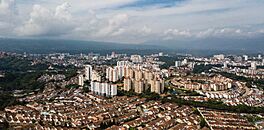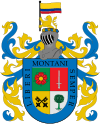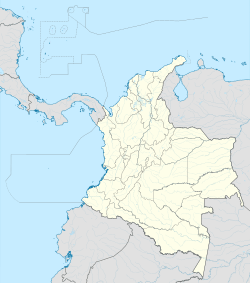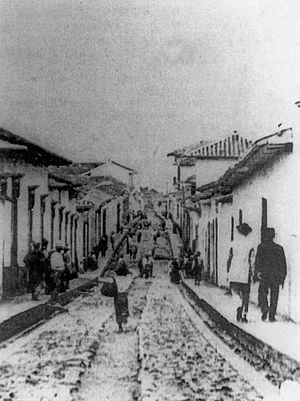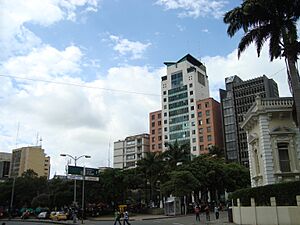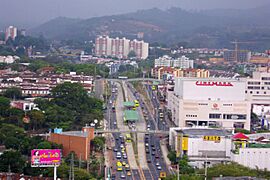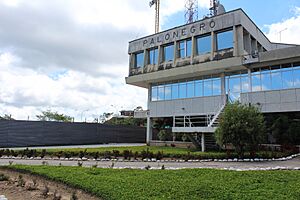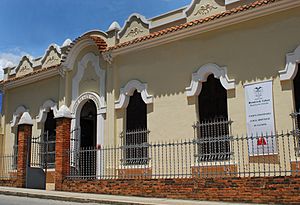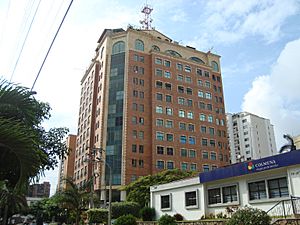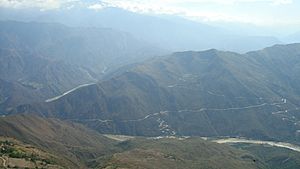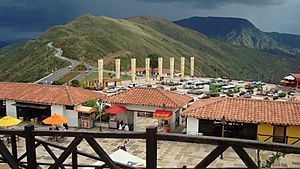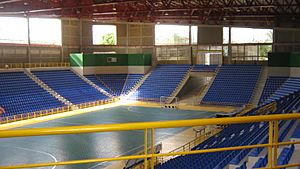Bucaramanga facts for kids
Quick facts for kids
Bucaramanga
|
|||
|---|---|---|---|
|
Municipality and city
|
|||
|
From top, left to right: Panoramic, Santander Park, Metropolitan Cathedral of the Holy Family and nocturnal view of the Provincial Viaduct.
|
|||
|
|||
| Nicknames:
La ciudad bonita (The Pretty City)
La ciudad de los parques (City of Parks) |
|||
| Motto(s):
Montani semper liberi
|
|||

Location of the city and municipality of Bucaramanga in the Santander Department
|
|||
| Country | |||
| Region | Andean Region | ||
| Department | Santander | ||
| Foundation | 22 December 1622 | ||
| Area | |||
| • Municipality and city | 152.9 km2 (59.0 sq mi) | ||
| • City | 55.31 km2 (21.36 sq mi) | ||
| Elevation | 959 m (3,146 ft) | ||
| Population
(2020 estimate)
|
|||
| • Municipality and city | 607,428 | ||
| • Density | 3,972.7/km2 (10,289/sq mi) | ||
| • Urban | 893,040 | ||
| • Metro | 1,304,288 | ||
| • City | 597,316 | ||
| • City density | 10,799.4/km2 (27,970.4/sq mi) | ||
| Demonym(s) | Bumangués | ||
| GDP (PPP, constant 2015 values) | |||
| • Year | 2023 | ||
| • Total | $22.7 billion | ||
| Time zone | UTC-05 (Eastern Time Zone) | ||
| Postal code |
680001-680011
|
||
| Area code(s) | 57 + 7 | ||
| Website | Official website: http://www.bucaramanga.gov.co/ | ||
Bucaramanga is a major city in Colombia. It is the capital of the Santander region. It's known as "The City of Parks" because it has over 160 parks. People also call it "Colombia's Beautiful City."
Bucaramanga is an important city for Colombia's economy. It has one of the lowest unemployment rates in the country. The city has grown a lot since the 1960s. It now connects with nearby towns like Floridablanca, Girón, and Piedecuesta. Together, they form the Bucaramanga Metropolitan Area, which has over 1.3 million people.
The city is also home to the Colombian Petroleum Institute (ICP). This is the research part of Ecopetrol, Colombia's state oil company.
Contents
History of Bucaramanga
Bucaramanga was founded on December 22, 1622. Before Bucaramanga grew, Girón was the main town in the area. Early on, Bucaramanga was an indigenous town. People came here to find gold in the rivers.
By 1779, it became known as a Parish. Its full name was the Parish of Our Lady of Chiquinquira and San Laureano de la Real de Minas de Bucaramanga. In the 1860s and 1870s, German merchants came to the city.
In 1886, Bucaramanga became the capital of the Santander department. It took over from Socorro. The region faced challenges, like the Thousand Days War (1899–1902). This war slowed down the city's growth in the early 1900s.
Climate and Geography
Bucaramanga is located on a high flat area called a plateau. This plateau is part of the Eastern Andes Mountains in Colombia. To the west, there's the Rio de Oro Canyon. To the east, the Andes mountains rise very high.
The city's official metropolitan area includes Girón, Piedecuesta, and Floridablanca. Lebrija, where Bucaramanga's airport is, is also considered part of the greater area. Even with lots of buildings, these towns still have large rural areas.
Bucaramanga has a tropical rainforest climate. This means it's generally warm and humid. The average temperature is around 22 degrees Celsius. The city's location means it gets cool winds from the mountains and warm air from the canyon. This helps keep the daily temperature changes small.
City Symbols
Municipal Flag
The flag of Bucaramanga was designed by Gustavo Gómez Mejía. It has two green stripes with a yellow one in the middle. In the center, there is a blue circle with a white star. A red circle surrounds the blue one. On the red circle, it says: "Below the azure of its sky and defended by the generous blood of its sons, Bucaramanga is opened to the four horizons of the motherland."
Municipal Coat of Arms
The city's coat of arms includes the Latin words Montani Semper Liberi. This means "Mountaineers are Always Free." This motto is also used by the U.S. State of West Virginia.
Population
Bucaramanga is a city with a growing population. In 2018, it had about 681,130 people. Slightly more than half of the population are women (52.5%). On average, about 3.6 people live in each home.
Most people in the city live in apartments (56.7%). About 39% live in houses. A small number (4.3%) live in rented rooms or other places.
Economy
Industry
Bucaramanga is well-known for its footwear industry. The Footwear Manufacturers' Association (Asoinducals) is located here. Shoes made in Bucaramanga are sold all over Colombia and in other countries. These include places like Argentina, Brazil, Canada, United States, and Mexico.
The city also has a large clothing industry. There are many research centers that study topics like energy, gas, oil, and leather. The Chimitá Industrial Zone is a big area with many companies. For example, Terpel has production plants there. The Bavaria Brewery, a major beer company, also has a plant in the city.
Bucaramanga is becoming a popular place for meetings and events. It has a large Fair and Exhibition Centre called CENFER. Many trade shows and exhibitions happen here every year. The city also has a center for big shows, sports, and business events. These events help other parts of the economy, like hotels, restaurants, and shops.
The International Exhibition of Children's Fashion (EIMI) is held in Bucaramanga. It is the only event of its kind in Latin America that focuses on children's clothing.
Business and Shopping
In recent years, Bucaramanga has built many large shopping centers. Some examples include La Florida, Megamall, Cacique, Parque Caracolí, and De la Cuesta. The "Cabecera del Llano" area has five major shopping centers.
These malls have many popular stores and entertainment options. You can find movie theaters like Cine Colombia and Cinemark. There are clothing stores like Adidas and Levi's. You can also find restaurants and cafes like McDonald's and Juan Valdez.
Big supermarket chains like Exito and Carrefour have several stores in the city. There are also local supermarket chains like Mercomfenalco.
Labor Market
Bucaramanga often has one of the lowest unemployment rates in Colombia. This means more people have jobs compared to other cities.
Transportation within the City
Metrolínea is Bucaramanga's public bus system. It started operating in 2009. It has many bus lines and stops that connect different parts of the city. The system is still growing to cover more areas.
On average, people in Bucaramanga spend about 57 minutes traveling by public transit on a weekday. They usually wait about 14 minutes at a bus stop. A typical bus trip covers about 5.6 kilometers.
National Road Connections
Bucaramanga is connected to other parts of Colombia by two main roads. One road, National Route 66, goes to Barrancabermeja and Cucuta. It also connects to Venezuela. The other road, National Route 45A, comes from Bogotá. This road links Bucaramanga to the Caribbean region of Colombia.
Air Transport
The main airport for Bucaramanga is Palonegro International Airport. It is located on a hill west of the city, near Lebrija. The airport opened in 1974. It has daily flights to most major cities in Colombia. There are also international flights, for example, to Panama. Palonegro International Airport is one of Colombia's most important airports.
Famous People from Bucaramanga
Many important Colombians come from Bucaramanga. These include Luis Carlos Galán, a presidential candidate, and Carlos Ardila Lülle, a very important businessman.
The Colombian artist Oscar Rodríguez Naranjo lived and taught art in Bucaramanga. He became the Director of the Academia de Bellas Artes in 1941.
Education
Bucaramanga is known for its many universities. Some of the well-known universities include:
- Industrial University of Santander (Universidad Industrial de Santander)
- Autonomous University of Bucaramanga (UNAB)
- Universidad de Santander (UDES)
- Unidades Tecnológicas de Santander (UTS)
- Saint Thomas Aquinas University (Universidad Santo Tomás)
- Pontifical Bolivarian University (Universidad Pontificia Bolivariana)
The Industrial University of Santander is a large public university. It offers many different programs in health, humanities, sciences, and engineering. It has about 14,000 students and is a leading university in the region.
Culture
Bucaramanga has a rich culture, especially in visual arts like painting and photography. The city has a history of supporting arts groups. Literature is also a big part of Bucaramanga's culture. Many writers have come from the city.
The Gabriel Turbay Public Library is now part of the Municipal Institute of Culture. This institute helps support cultural activities in the city. It offers library services, art workshops, and cultural shows. The city also has a cultural radio station, Station Cultural Luis Carlos Galán Sarmiento, on 100.7 FM.
Gastronomy (Food)
Bucaramanga has many unique local dishes. Some popular foods include:
- Mute santandereano: A hearty soup made with grains, vegetables, herbs, and meat.
- Fricassee: A dish with goat meat and blood mixed with white rice.
- Arepa de maize pelado: A type of corn cake.
- Tamales: A traditional dish wrapped in leaves.
The city is also famous for its sweets. You can find candied celery, lemon, and pineapple. The oblea (a thin wafer) and bocadillo veleño (a fruit paste candy) are also very popular.
One of the most unique foods is the “hormigas culonas” or “big-butt ants.” These ants are a local delicacy and are even exported to other countries. They are high in protein and have been eaten by local people for a very long time. You can only find them during May and June, when they come out of the ground.
Tourism
Bucaramanga and its nearby towns offer many types of tourism. You can enjoy nature in its parks or try adventure sports like Paragliding at "Voladero the Águilas." This spot is only a 15-minute drive from the city.
The city center has old colonial buildings. These include the churches of San Laureano and the Dolores Chapel. You can also visit historic houses, like the house of Simon Bolivar. Bucaramanga is known as one of Colombia's top tourism spots.
The city has many good hotels. There are also many restaurants and nightclubs, especially in the city center.
Lookouts
- Morrorico: This spot is east of Bucaramanga, on the road to Cucuta. From here, you can see a great view of the city. There is also a statue of the Sacred Heart here.
- Palonegro: Located on the road to Palonegro Airport, this lookout offers a beautiful view of the entire metropolitan area. It's a popular spot, especially on weekends.
Natural and Historic Attractions
- Chicamocha National Park (PANACHI): This park is on the road to Bogotá. It offers amazing views of the huge Chicamocha River Canyon. You can see the canyons of the Chicamocha and Suarez rivers from here.
- Giron: About 9 kilometers from Bucaramanga, Girón was founded in 1631. It was important for gold mining long ago. It has beautiful old buildings and is a national monument. You can visit the Museum of Religious Art and the Basilica of the Lord of Miracles.
- Socorro: About 121 kilometers from Bucaramanga, Socorro is famous for the "Revolt of the Communards." This uprising happened in 1781 when Manuela Beltrán protested against high taxes. You can see monuments to leaders like José Antonio Galán.
- Barichara: About 118 kilometers from Bucaramanga, Barichara is known as "the Cutest little town in Colombia." It has charming cobblestone streets and wooden balconies.
- Guane: A colonial village near Barichara with a 17th-century church and an Archaeological Museum. The museum has old books and fossils.
- San Gil: About 96 kilometers from Bucaramanga, San Gil has steep streets and is a National Monument. The Gallineral park is a must-see, with moss hanging from trees. San Gil is also popular for adventure sports like rafting and mountain biking.
Sports
Indersantander and Inderbu are the groups that manage sports in Santander.
Football
Bucaramanga has the Estadio Alfonso López, a football stadium that can hold 28,000 people. It is the home stadium for the local football teams Atlético Bucaramanga and Real Santander.
Other Sports
The Coliseo Bicentenario is a large sports arena built in 2011. It can hold 8,000 spectators. It is the home stadium for the Búcaros Santander basketball team. Another sports complex is the Edmundo Luna Santos Coliseum.
Bucaramanga has hosted the National Games twice, in 1941 and 1996. It also hosted the Pan American Cycling Championships in 2000. In 2016, Bucaramanga was one of the cities that hosted the 2016 FIFA Futsal World Cup.
See also
 In Spanish: Bucaramanga para niños
In Spanish: Bucaramanga para niños


